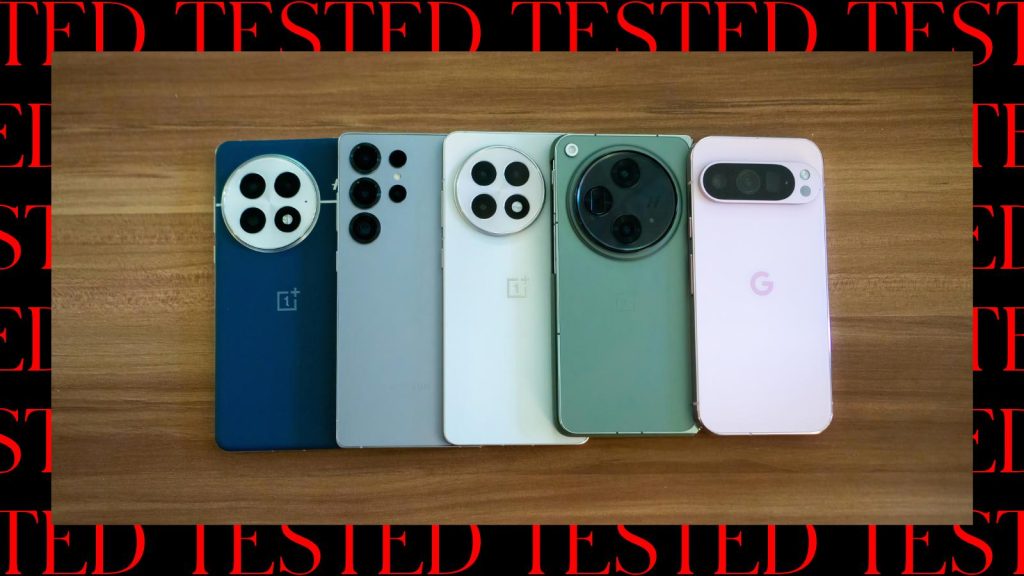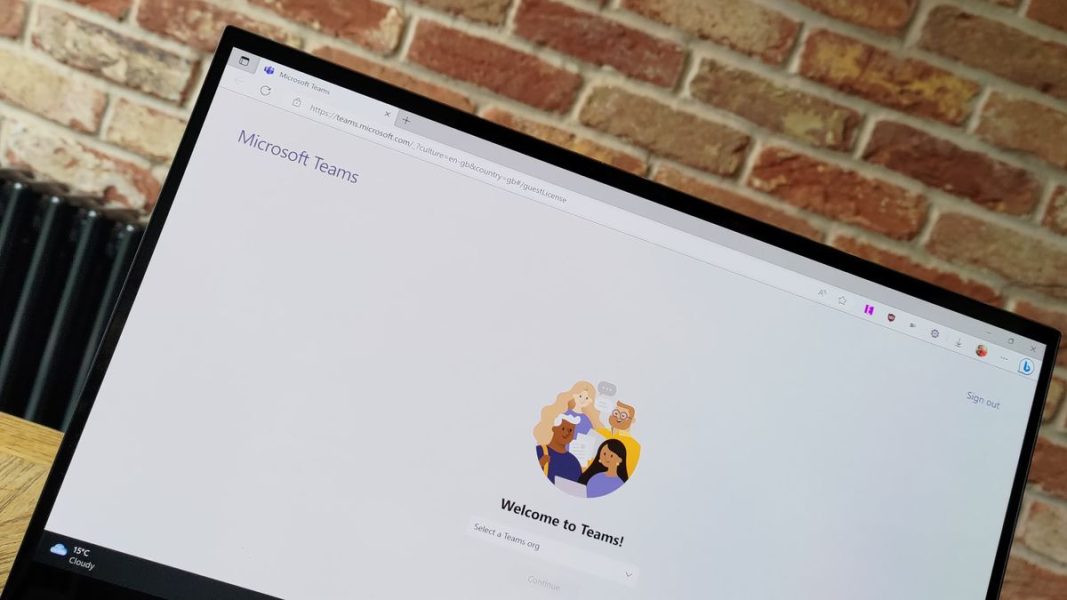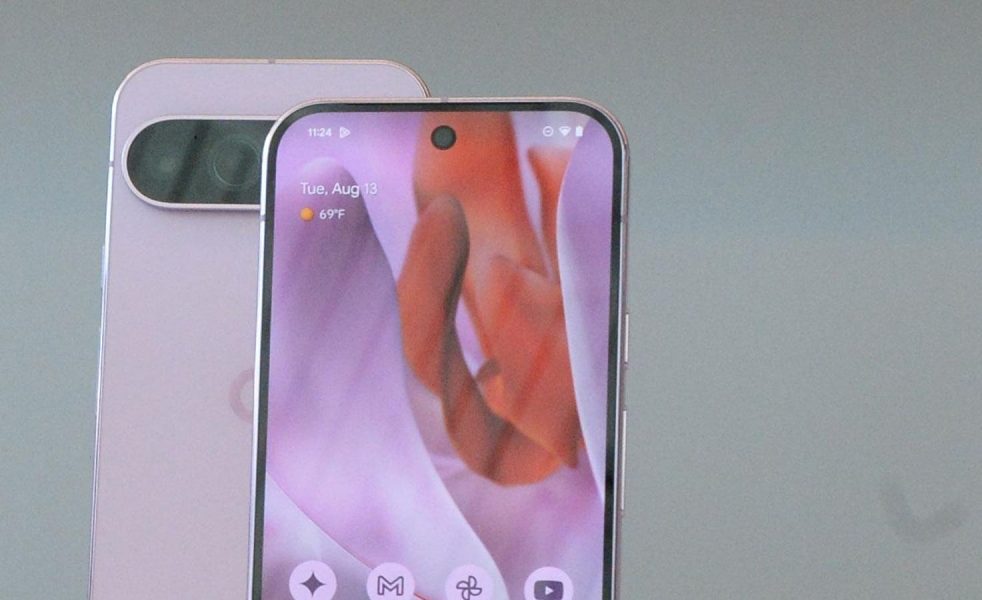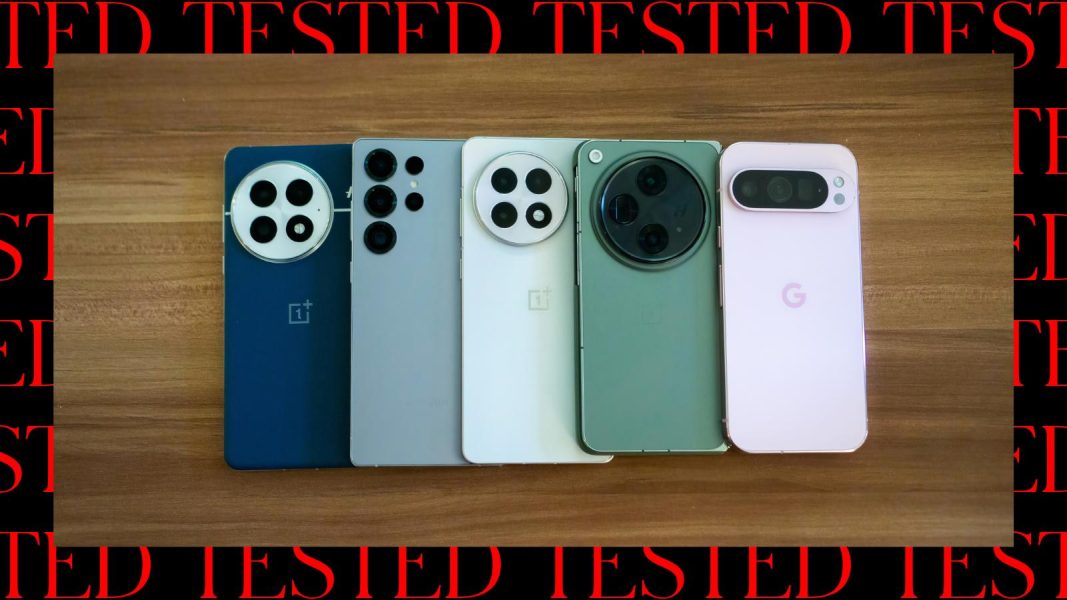The Best Android Phones, According To Rigorous Testing – Forbes

With top-tier cameras, blazing-fast performance and more AI features at your fingertips than ever, the best Android phones allow you to customize your entire mobile experience. Our top pick, the Samsung Galaxy S25 Ultra, packs Galaxy AI in addition to powerful cameras that make it stand out from the pack.I spent several months testing the best Android phones for a week each. Here are my top picks.But there are plenty of worthy options beyond the Samsung Galaxy S25 Ultra as well, including foldables, budget-friendly phones and more. If you want equally powerful performance in a smaller package, the Google Pixel 9 Pro is another great option; for something a bit more affordable, the OnePlus 13R is available for around $600. Here are the best Android phones, based on our firsthand testing.SamsungForbes VettedForbes Vetted ratings are based on thorough evaluations by our editorial team to help you choose the best products with confidence.Display size: 6.9 inches | Display type: 3,120 x 1,440-pixel AMOLED, up to 120Hz adaptive refresh rate | RAM: 12GB | Storage: 256GB, 512TB and 1TB | Battery: 5,000mAh | Front camera: 12MP | Rear camera: 50MP ultrawide, 200MP wide, 10MP 3x optical zoom, 50MP 5x optical zoom | Processor: Snapdragon 8 Elite for GalaxyBest for:Skip if:The Samsung Galaxy S25 Ultra is not only the best Android phone, it’s also one of the best phones on the market right now, period—and it stands on solid ground to nab that title. Samsung removed the boxy edges in favor of curved edges, and it now sports a 6.9-inch AMOLED display, up from 6.8 inches thanks a slight decrease in bezels. Underneath the titanium chassis, it gets the latest Qualcomm Snapdragon 8 Elite for Galaxy, upgraded over its predecessor’s Qualcomm Snapdragon 8 Gen 3 chipset; after running multiple benchmarking tests, it blows the competition out of the water. It also packs 12GB RAM, and you can get it in 256GB, 512GB or 1TB options.The Samsung Galaxy S25 Ultra slimmed the bezels to add another 0.1-inch of display space. It looks … [+] great.But it’s not these hardware features that make it my top pick: It’s the software. Alongside its announcement at Samsung Unpacked, Samsung launched a slew of new Galaxy AI features, including the Now Bar and Now Brief, a lock-screen notification bar and an AI-built single app page that compiles at-a-glance information including the weather and news stories, respectively. Circle to Search also received upgrades, and you can use the device to search music, even if you simply hum the tune, which I found simply delightful during multiple rounds of testing.In addition, Samsung expanded its partnership with Google, and you can activate Google Gemini by long-pressing the power button. Just be sure to double-check its answers: When I asked what time I should leave San Jose, California to arrive at San Francisco Airport for a 10:45 a.m. flight, it told me to leave a 8:45 a.m., which was wildly off-mark when factoring in traffic. Otherwise, it’s nice to have for dinner suggestions or trip itineraries on the fly.Now Brief collects all your at-a-glance information into one page. Check events, weather and more.But for me, the biggest claim to fame is the camera set Samsung packs into this phone. The Samsung Galaxy S25 Ultra adds a new 50MP ultrawide camera that takes more detailed and more colorful photos than its predecessor, the Samsung Galaxy S24 Ultra. Comparatively, OnePlus 13 sports a 50MP ultrawide, and the Google Pixel 9 Pro has a 48MP ultrawide lens. It really was time for Samsung to step up to the plate, and it delivered.The new software made the Golden Gate Bridge look vibrant and sunning during golden hour.I pitted the Samsung Galaxy S24 Ultra against the S25 Ultra in photographing the Painted Ladies in San Francisco, and the S25 Ultra gave me more detail with brighter saturation. The same went for testing against the reds of the Golden Gate Bridge: The Samsung S25 Ultra images looked more vivid and detailed compared to the S24 Ultra. For more details about the device, you can read my full Samsung Galaxy S25 Ultra review.AmazonForbes VettedForbes Vetted ratings are based on thorough evaluations by our editorial team to help you choose the best products with confidence.Display size: 6.3 inches | Display type: Super Actua, up to 120Hz variable refresh rate, 1280 x 2856 resolution | RAM: 16GB | Storage: 128GB, 256GB | Battery: 4,700mAh | Front Camera: 42MP | Rear Camera: 50MP wide, 48MP ultrawide, 48MP telephoto | Processor: Google Tensor G4 Best for:Skip if:Plenty of devices can feel bulky when you hold it them your hand. One solution tech companies have turned to is to offer two size options; Apple did it with the iPhone 16 Pro and its larger sibling, the iPhone 16 Pro Max. This year, Google joined into this fold and introduced two sizes to its flagship Pixel lineup: the Google Pixel 9 Pro Max and the smaller version, the Google Pixel 9 Pro. The latter has the same features as its larger sibling but sports a 6.3-inch Super Actua display with a 120Hz variable refresh rate. I love how comfortable it is to hold in my hand, especially when compared to the bulk of the Samsung Galaxy S25 Ultra, the Samsung Galaxy S24 Ultra and others.The new camera array on the back of the device juts out.The Google Pixel 9 Pro packs 16GB RAM into the device and the Tensor G4 chip is strong enough to handle all of your processing needs—just don’t expect it to compete with the powerful Qualcomm Snapdragon 8 Elite for Galaxy the Samsung uses. In testing, benchmarking showed that the Pixel 9 Pro fell behind. But, to be fair, you won’t notice this during daily use, even when you’re actively trying to run the strongest applications imaginable.Again, my favorite part about this phone is the camera. The collective 50MP, 48MP and 42MP lenses capture images beautifully. I’m caught between two worlds here: On one hand, I prefer the look of the hyper-detailed images the Google Pixel produces, but I also love the color processing the Samsung Galaxy S25 Ultra offers. It’s a tough call and really comes down to personal preference—there’s no wrong answer.The creepy old castle I suggested to Magic Editor looks very realistic—so much so that even the … [+] lighting changes a bit in the edited image.Another important distinction is the Galaxy versus Pixel software. While Samsung phones collaborate with and now offer Google Gemini from the power button, most AI on Android truly is Google’s turf, and as such, you get a slew of useful AI features with the Pixel 9 Pro. Add Me is one that allows you to snap a photo and insert yourself in by taking a “second” photo over the first to incorporate everyone into the shot—the photographer included. You also get a fun feature called Magic Editor, software that can alter the image to your liking with a couple on-photo highlights and AI prompts. In my review, I felt it was a mixed bag, but it’s a nice way to let your creativity shine for friends and family. Just keep in mind that it doesn’t watermark images as altered by AI.OnePlusDisplay size: 6.8 inches | Display type: 120Hz ProXDR Display with LTPO 4.1 (3,168 x 1,440 pixel resolution) | RAM: Up to 16GB | Storage: Up to 512GB | Battery: 6,000mAh | Front camera: 32MP | Rear camera: 50MP (main), 50MP ultrawide, 50MP 3X telephoto | Processor: Qualcomm Snapdragon 8 EliteBest for:Skip if:OnePlus 13 is designed with IP68 and IP69 waterproofing; so during testing for my review, I actually threw it in the washing machine and dishwasher to confirm how sturdy its claim was. I don’t recommend doing this to any device, but when the OnePlus team told me to toss it in the wash, I took the risk. Sure enough, after a couple turns in each appliance, it still worked just as well as before it went through multiple wash cycles.Upgrades to the OnePlus 13 includes MagSafe charging via an insert panel.Its real claim to fame, however, is battery life. The Google Pixel 9 Pro XL and the Samsung Galaxy S25 Ultra sport 5,060mAh and 5,000mAh, respectively. The OnePlus 13 blows them out of the water by introducing a 6,000mAh battery—the biggest available on the market by far. Even better: It doesn’t affect the device’s weight in my hand. In addition to packing this massive battery under the hood, the OnePlus 13 supports MagSafe charging with its branded case. It also supports up to 100W charging. Note that U.S. charging standards allow only up to 80W charging, but still, it’s a fast number—and at its fastest, you can get a full charge in around 45 minutes. Oh, and it’s also wireless charging–compatible and comes with its own wireless charging station, sold separately. Put simply, this phone was born and bred to outlast the competition.The OnePlus 13 features Hasselblad technology in its camera system.The cameras during testing also showcased how OnePlus is transforming the camera space for the better. It features a Sony-designed 50MP main camera, a 3x 50MP triprism telephoto lens and a 50MP ultrawide lens. Tack on the Hasselblad technology and this is a very, very powerful camera set. I tested it frequently on my cat, a tabby named Toby, and reviewed the blown-up images on my 27-inch monitor. His speckled coat looked gorgeously refined in these images. The zoom consistently outperformed Samsung’s zoom, too, and this is partially because, in a nutshell, OnePlus uses an AI software that deep scans the image and upscales them. It’s very impressive. I still preferred Samsung’s post-processing saturation, but OnePlus is the camera to beat, in my opinion.Portrait modes look great on the OnePlus 13.Its also has extras including Clear Burst, which captures action shots gorgeously, and Action Mode, a video feature that smooths out videos of my cats playing so well I feel like I’m watching a Sony-produced movie. These two features really make the OnePlus 13 a strong contender for the best Android phone overall. But some of the UI features annoyed me. Grouping my apps into folders was a major pain point. Its “Shelf” feature under the Global Search bar at the top also left something to be desired; I couldn’t get it to function correctly during testing. And ultimately, that’s why it’s not the overall winner here. But if you’re not using AI or don’t care too much about it, then this is my favorite phone of 2025 so far.AmazonForbes VettedForbes Vetted ratings are based on thorough evaluations by our editorial team to help you choose the best products with confidence.Display size: 6.3-inch (external), 7.8-inch (internal, unfolded) | Display type: Flexi fluid AMOLED, up to 120Hz variable refresh rate | RAM: 16GB | Storage: 512GB | Battery: 4,805mAh | Front camera: 32MP Cover screen, 20MP front lens | Rear camera: 48MP main, 64MP telephoto and 48MP ultrawide | Processor: Qualcomm Snapdragon 8 Gen 2Best for:Skip if:The OnePlus Open may be the first iteration of OnePlus’ foldables lineup, but it quickly overtook its competition to be the best foldable on the market. I use the term “foldable” loosely: This device uses a flexi fluid AMOLED display that doesn’t directly fold but curves under the hood when the phone closes. It’s a great design choice that feels durable when I open and close it, and it shines when I’m watching content. Why? Because it doesn’t show the crease nearly as much as the competition—it’s practically invisible at varying angles.The OnePlus Open cameras also feature Hasselblad technology.When unfolded, the display measures 7.8 inches with a 2K resolution. Powered by the Qualcomm Snapdragon 8 Gen 2 processor and paired with 16GB of RAM, this device can handle almost anything you toss at it. (That said, the processor is beginning to show its age a bit compared to the competition, but odds are you won’t notice too much during everyday use.) It also features Wi-Fi 7, so you also have the strongest network connectivity hardware and software on the market, which feels pretty speedy when I’m online gaming. I personally also loved testing it for reading and casual internet browsing, and I felt it showcased beautifully as a productivity device. You can split the screen to multitask; as an example, within LinkedIn you can scroll through your feed on one half and pull up a post on the other. This software alone helps it nab its superlative in this list.Watch your favorite shows and game on the massive display. Note that you can’t see the crease from … [+] this angle.One of my biggest qualms is that this device launched in 2023, and over a year in, the cameras don’t have quite the processing power to take the absolute best shots. Will you still get great images and video content if you use this? Absolutely—and don’t let my minor griping sway you too much. But it’s not going to be power that you’ll get from its sibling, the OnePlus 13, or competition like the Samsung Galaxy S25 Ultra, but it will be better than the Samsung Galaxy Z Fold 6. If you want to take selfies, turn the camera around and use the exterior cameras as your main.My model may have started snoozing, but the OnePlus Open captured his tabby markings quite nicely.And again, OnePlus storms past the competition when it comes to battery life and charging: The 4,805mAh battery can charge from 20% to full in around 35 minutes. If you use the device constantly throughout the day, you’ll find that your battery may not last you as long as you want, but that’s also partially the price you pay for such a massive, beautiful display. It’s also worth noting that at this time, the device doesn’t come with stylus support. You can “hack” it to support one, but I personally don’t recommend it since that could come at the cost of the display’s durability.You’ll also pay a premium price for that display, so if you can stomach a $1,700 price tag, it’s worth your dollar. You can read the OnePlus Open review to learn more about this device, too.OnePlusForbes VettedForbes Vetted ratings are based on thorough evaluations by our editorial team to help you choose the best products with confidence.Display size: 6.7 inches | Display type: 120Hz ProXDR Display with LTPO 4.1 (3,168 x 1,440 pixel resolution) | RAM: 12GB | Storage: 256GB | Battery: 6,000mAh | Front camera: 16MP | Rear camera: 50MP main, 50MP ultrawide, 50MP 3x telephoto | Processor: Qualcomm Snapdragon 8 Gen 3Best for:Skip if:The OnePlus 13R, my pick for a midrange-priced Android phone, rounds out a series of solid mobile devices the company has launched in recent months. Like the OnePlus 13, the 13R packs a ton of AI and hardware features. Even more enticing: It doesn’t require you to drop over a thousand dollars. For most people, 256B of storage is more than enough, and the same goes for the 12GB RAM. The Qualcomm Snapdragon 8 Gen 3 may be a 2024 chipset, but it’s powerful enough to be used in a slew of 2024’s flagship devices. When I’ve tested it during gaming, I haven’t seen any real differences, and it’s still very speedy when I’m surfing the internet or multitasking.The OnePlus 13R has a similar design to the OnePlus 13.It also packs that massive 6,000mAh battery life, so you can expect your device to last all day and a good chunk into the night if you’re a power-hungry user. It was one of the major perks during my testing of the device, but it wasn’t the only one. I tested the 50MP cameras as well and was pleasantly surprised by just how good they were. OnePlus photography doesn’t do well in darker lighting, and that verdict holds up here, so that’s something to consider. Otherwise, it’s a great set, and it should more than suffice for most of your needs. Plus, unless you’re like me and blowing them up for careful review on a 27-inch monitor, you’re not going to notice–they’re perfectly fine for social media and snapping photos of your family on vacation.The OnePlus 13R offers a pretty powerful camera system.Long-press the right button to activate Google Gemini, too, for all of your on-the-fly questions. Again, however, because it’s AI, be sure to cross-check your answers. I felt Gemini to be a wonderful addition, though, and impressive considering most devices that offer this feature cost at least $200 more at the time of publication. And of course, MagSafe compatibility is locked to the OnePlus 13. If you’re not worried about that, it still offers fast (wired, not wireless) charging if you need a quick boost.Most phones of this scale can cost you $1,000 and over. The OnePlus 13R takes all of these top-of-the-line features and keeps it at $600, which feels like a feat in itself. You can’t customize its internal RAM or storage, and you can only expect four years of software and six years of security updates, but that’s a small sacrifice for such a grand device.MotorolaForbes VettedForbes Vetted ratings are based on thorough evaluations by our editorial team to help you choose the best products with confidence.Display size: 6.8 inches | Display type: LCD FHD with 120Hz refresh rate (1,604 x 720 pixel resolution) | RAM: 8GB, expandable up to 14GB with RAM Boost | Storage: 128GB, with 1TB microSD card expandable | Battery: 5,000mAh | Front camera: 16MP | Rear camera: 50MP main, 2MP Macro vision | Processor: MediaTek Dimensity 6300Best for:Skip if:Motorola’s Moto G Power is my budget pick for an Android phone. It has a pretty comfortable grip, with a snazzy, water-resistant vegan leather covering on the back. The leaf green color I received is a simply lovely hue, too; I wish more companies would lean into these gorgeous jewel tones. At 193 grams, it’s lighter than the Samsung Galaxy S25 Ultra, and it comes with IP68/IP69 waterproofing, which is a first for this price point and puts it in line with the OnePlus 13.The Motorola Moto G Power has a lovely vegan leather backing. I’m in love with this leaf-green … [+] shade.While the design looks sleek and adds some big perks, the $300 price tag means you’re going to have to sacrifice some major features. The result of that balance? The camera set is pretty no-frills. It does the job well, with a 16MP front lens and a 50MP main. Tack on a 2MP macro lens and casual phone users will be pleased with the results. After being spoiled by Samsung, Google and OnePlus, I can spot blurry spots on Toby’s coat, but if you’re looking to call, text, check the web and snap casual images, you’ll be happy with this phone.Moto Actions—unique gestures on your Motorola phones—are, quite frankly, genius. Making a chopping motion twice and your flashlight turns on or off; gently press three fingers on the display to capture a screenshot. I loved Swipe to Split, which does exactly as it sounds: It splits the display for multitasking.The Gametime mode lets you see CPU and RAM usage in real time when you’re gaming.The Moto G’s gaming modes, called Gametime, were pretty nifty, too. I tested it on Stardew Valley and found the controls pretty responsive, and a pop-up window helps see your hardware running in real time. Viewing the CPU and RAM and the power used was useful, too, as I could adjust my gaming power for my gaming needs via three modes: Turbo, Balanced and Battery Saving.The camera takes pretty good images that will please casual phone users.I would also be remiss if I didn’t mention one more design feature: the built-in microSD card slot. It’s been a hot minute since I’ve seen a phone with expandable storage, and I’m all here for it. At 128GB, it probably won’t be enough if you’re a frequent photographer or videographer, and you should plan to tack on a microSD card.A story more than 18 months in the making, I put each Android device on this list through its paces. Over the course of several months, I used each device for at least one week—and often, more than several weeks—taking calls, snapping photos and more. In January 2025, I was on the ground in San Jose, California at the 2025 Samsung Unpacked event. There, I attended multiple forums to learn more about the new Galaxy AI features available in the top pick, the Samsung Galaxy S25 Ultra. I have also been an attendee at multiple Google briefings to learn more about its Android devices, including the Google Pixel 9 Pro. Additionally, I went to a slew of OnePlus briefings, both virtually and in person, to understand more about the hardware and software packed into each device.I carefully reviewed each Android phone’s specs, taking into account processors, RAM and overall build quality. From there, I narrowed down my choices, considering various needs, from a casual user to a dedicated mobile gamer who requires a powerful vapor chamber and processor for the best gaming experience. I also considered those who may want to jump into the foldable lineup, too.I put the cameras through their paces, cross-testing each lens against one another under a variety of circumstances. While many of these cameras made their way around the world for testing, including Mexico, France and more, I mainly tested the cameras around New York City. I also used my three cats and husband as models for testing portrait shots on each device.In addition to the hardware, I placed a heavy focus on each Android device’s AI integrations, using each device’s latest features, from the new Now Brief on the Samsung Galaxy S25 Ultra to Google Gemini on the OnePlus 13, OnePlus 13R and more to see how each mobile device performed under various tests.I’ve been a tech journalist for over five years, including more than a year as the consumer tech and electronics editor at Forbes Vetted. In addition to testing the best gaming TVs and the best TVs for bright rooms, I’ve spent time interacting with the latest smart wearables and audio devices currently on the market, from the Ray-Ban Meta Smart Glasses to the SteelSeries Arctis Nova GameBuds and more.In my time testing phones, I focused on aspects of interest to everyone, from folks who prefer a simple call-and-text device to heavy-duty mobile gamers who want a powerful and seamless experience. As a result, my testing more so mimics how general users as well as content creators who want to capture gorgeous footage for their feeds may interact with these phones.In addition to testing all the phones on this list, I’ve spent plenty of time testing a slew of mobile devices from other brands. I’ve deep-dived into the Apple ecosystem with the iPhone 16 Pro and reviewed plenty of Android devices, including the Samsung Galaxy Z Flip 6, the Samsung Galaxy S24 Ultra and the Google Pixel 8. Before writing this list, I tested the Samsung Galaxy S25 Ultra, the very latest Android device to launch so far this year.While the best Android phone ultimately depends on what you’re looking for, based on my testing, I named the Samsung Galaxy S25 Ultra the top pick. It earned this distinction thanks to its powerful processor, great camera set and useful Galaxy AI. Plus, it features the new One UI 7 for more security protections.The Samsung Galaxy S25 Ultra is my top pick for an Android phone for photography, as it can capture images with great detail and has a strong post-processing to enhance your images. “As a professional photographer, the Samsung excels as far as phone photography goes, and its 5x optical zoom lenses really does capture amazing detail of far away objects and scenes,” says Sebastien Coell, a professional landscape photographer. He also stressed that you shouldn’t get caught up in the megapixel sizes. “A 200MP ultra-range sensor allows for high-resolution images, but it’s important to remember that megapixels alone don’t determine image quality—sensor size, light capture and processing all play key roles,” to make your photos stand out.Another great option? The Google Pixel 9 Pro, according to Jeremy Rambarran, Professor at Touro University Graduate School of Technology. It’s a great all-around phone, but its camera system also stands out, as Rambarran says, “for low light photography. Its [camera] operation as a whole is helped by Google’s AI-driven technology.”Choosing the right Android device ultimately depends on what you’re looking for. Regarding software, many phones offer multi-year support, “Google phones get the fastest updates, while Samsung offers longer-term support,” says Rambarran.If you’re seeking a top camera, the Samsung Galaxy S25 Ultra and the Google Pixel 9 Pro are solid contenders for your next device, as they have a best-in-class camera systems that capture images beautifully. Also consider durability, as you’ll want make sure your phone is protected from accidental drops or contact with water.And if you’re most focused on cost, take a look at the Motorola Moto G Power, which gives you a solid balance of performance, power and price for just $300.
Source: https://www.forbes.com/sites/forbes-personal-shopper/article/best-android-phone/



